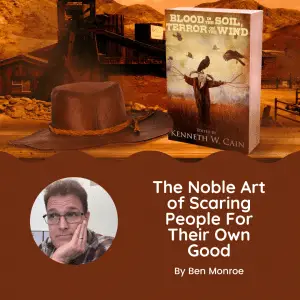The Noble Art of Scaring People For Their Own Good
 The Noble Art of Scaring People For Their Own Good
The Noble Art of Scaring People For Their Own Good
by Ben Monroe
“There is no delight the equal of dread…” – Clive Barker
When I was a teenager in the 80s, the neighborhood video stores and scifi book shop were two of my favorite haunts. While I read a little scifi and fantasy from time to time, by the time I was a teen I was mostly just looking for the horror titles. Of course, back then, that store didn’t segregate based on marketing categories. Everything was just lumped in together, alphabetized by author, and I had to either know exactly what author I wanted to read, or more frequently would just go browsing until I found something that looked interesting, and go with that.
The mainstream bookstores (Waldenbooks and Crown Books) were a little better organized. At least there was a distinction between Horror and Science Fiction. That made it a little easier to find whatever I was looking for.
The video store was roughly the same. The mainstream movies were at the front, science fiction spaced further away, and then the horror section relegated all the way to the back, right next to the beaded curtains which hid the “Adult” section. I recall being back there one time, scanning the lurid covers of the horror video tapes, when I overheard an older woman’s voice. She’d clearly accidentally stumbled into the horror section, and did not approve. “I don’t know why people want to watch such garbage nowadays,” she said, and I suddenly realized she was asking me a question, not making a statement.
I just shrugged. “I don’t know,” I replied. “Sometimes it’s just fun to be scared.”
Over the years I’ve been paying attention to the genre, I’ve heard that “nowadays” statement come up repeatedly. Every time the genre becomes somewhat popular to mainstream audiences, people wonder “what’s wrong with people today?” that they want to experience second-hand horrors.
But is there really any more primitive, more primal, more ancient storytelling tradition than the horror tale?
Witness The Odyssey, an epic adventure saga filled with heroism, sacrifice, gods and magic. Taught in classics courses and indelibly part of the western canon. It also includes such things as the chapter where the Cyclops, Polyphemus captures Odysseus’ men and then eats them raw, gets drunk and vomits up bits of them, before Odysseus stabs out the monster’s eye with a fiery spear. A scene of pure horror which was exciting enough that it wormed its way across the world into both the Arabic tales of Sindbad and the Norse saga of Arrow Odd.
Or Beowulf, the classic English poem, in which a monstrous creature slinks out of a nearby swamp to attack revelers in the hall of Heorot. The monster Grendel (noted as a descendent of the Biblical Cain in the earliest surviving manuscript) tears an army of vikings limb from limb, splattering the hall with gore. And while Grendel itself is clearly a predecessor of monsters of the Jason Voorhees ilk, it’s also worth considering how James Cameron re-skinned and repurposed the structure of the story for his film ALIENS.
Come forward in time, and listen to the story of Little Red Riding Hood, in which a monstrous wolf devours an old woman, dresses in her clothes, and lurks in wait for the granddaughter coming to visit. I’ve often wondered if Tobe Hooper intentionally used that story as the basis for The Texas Chain Saw Massacre.
One can imagine that the earliest tales told around the hearth fires of ancient people were the precursors of the modern horror tale. Cautionary tales told by the local storyteller to warn his tribesmates of things not to do. Modern folk like you and I know that a wolf or a bear is just an animal. But to ancient man, they would be demons or monsters. “Don’t leave the circle of firelight or monsters will eat you.” “Don’t travel far from the village or the witches will get you.”
While a well-told horror story has certain intrinsic elements of pure entertainment, at their core, they’re cautionary tales. Tales meant to warn, to foreshadow. They distill the anxieties of the time, mask them in metaphor, and deliver warnings to the audience. It’s never been much of a surprise to me that the zombie tale regained popularity right around the time of the 9/11 attacks, and the first outbreaks of SARS. The lesson there: Horror can strike out of the blue, and spread like wildfire.
So when writing in the genre, it’s often worth thinking a little about what sort of warning we might want to deliver to our readers. Sure, we must tell a story which is entertaining and thrilling first. But we’re the inheritors of an ancient art, a noble endeavor. What do you want to warn your audience about? What fears do you hold others need to be cautioned about?
And don’t let anyone make you feel you’re less important because you’re writing in the horror genre. Like telling tales of ghosts and ghouls isn’t a worthy pursuit. You’re part of a tradition which reaches back through time from “nowadays,” to the earliest days of humanity.
Here be dragons. And our job is to warn people about them.
- About the Author
- Latest Posts
Ben Monroe has spent most of his life in Northern California, where he lives in the East Bay Area with his wife and two children. He is the author of In the Belly of the Beast and Other Tales of Cthulhu Wars, The Seething (coming in 2023 from Brigids Gate Press), the graphic novel Planet Apocalypse, and short stories in several anthologies. His latest story “the Patchwork Man” appears in Blood In the Soil, Terror On the Wind from Brigids Gate Press. You can find more information about him and his work at www.benmonroe.com













